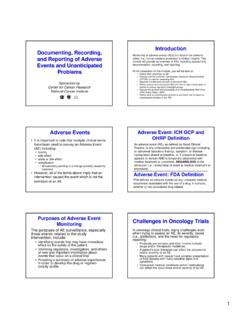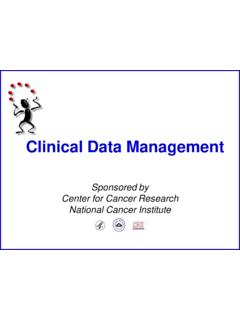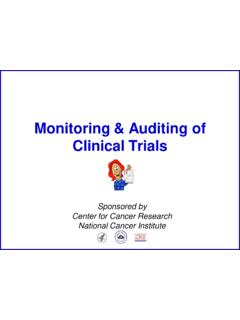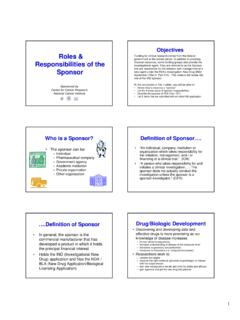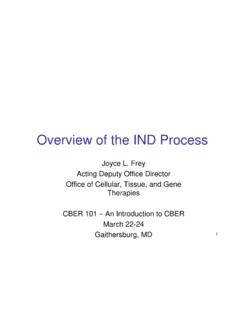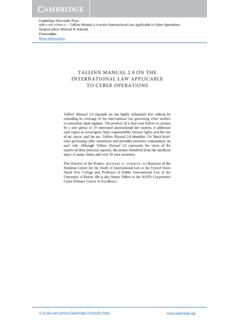Transcription of Documenting, Recording, and Reporting of Adverse Events ...
1 documenting , recording , and Reporting of Adverse Events and Unanticipated Problems Sponsored by Center for Cancer Research National Cancer Institute Introduction Monitoring of Adverse Events (AEs) is critical to the patient s safety ( , human subjects protection) and data integrity. This module will provide an overview of AEs, including assessment, documentation, recording , and Reporting . At the conclusion of this module, you will be able to: Define what constitutes an AE. Discuss how the Common Terminology Criteria for Adverse Events (CTCAE) is used for assessing AEs. Describe the elements required to document AEs. Define serious and unexpected AEs and how to report these types of Events to various regulatory/oversight groups. Discuss the purpose and processing of an Investigational New Drug (IND) Safety Report (ISR). Define what an unanticipated problem is and learn how to report an unanticipated problem to the IRB. Adverse Events It is important to note that multiple clinical terms have been used to convey an Adverse Event (AE) including: toxicity side effect acute or late effect complication all essentially pointing to a change possibly caused by treatment However, all of the terms above imply that an intervention caused the event which is not the definition of an AE.
2 3 Adverse Event: ICH GCP and OHRP Definition An Adverse event (AE), as defined by Good Clinical Practice, is any unfavorable and unintended sign (including an abnormal laboratory finding), symptom, or disease having been absent at baseline, or, if present at baseline, appears to worsen AND is temporally associated with medical treatment or procedure, REGARDLESS of the attribution ( , relationship of event to medical treatment or procedure). Adverse Event: FDA Definition FDA defines an Adverse Events as any untoward medical occurrence associated with the use of a drug in humans, whether or not considered drug related. Purposes of Adverse Event Monitoring The purposes of AE surveillance, especially those Events related to the study intervention, include: Identifying Events that may have immediate effect on the safety of the patient Informing regulators, investigators, and others of new and important information about Events that occur on a clinical trial Providing a summary of Adverse experiences in order to develop the drug or regimen toxicity profile Challenges in Oncology Trials In oncology clinical trials, many challenges exist when trying to assess an AE, its severity, cause ( , attribution ), and the need for regulatory Reporting : Protocols are complex and often involve multiple drugs and/or therapeutic modalities.
3 A patient s prior therapies can affect the occurrence and/or severity of an AE. Many patients with cancer have complex presentation of their disease with many baseline signs and symptoms. Concurrent medical conditions and/or medications can affect the occurrence and/or severity of an AE. ASSESSMENT Assessing Adverse Events is done by the PI or designee (member of the research team) and includes determining the following: Severity of event attribution of the event This assessment + expectedness of the event helps in determining the timeliness for Reporting of event to the IRB, Sponsor, or other regulatory/ oversight groups. The next several pages will first address the severity assessment in oncology clinical trials followed with attribution assessment. Severity Assessment The tool used to determine the severity of an AE in oncology clinical trials is the Common Terminology Criteria for Adverse Events (CTCAE) The Cancer Therapy Evaluation Program (CTEP) of NCI developed the original Common Toxicity Criteria (CTC) in 1983 to aid in the recognition and grading severity of Adverse effects of chemotherapy Fundamentally intended to be an agreed upon terminology for the designation, Reporting and grading of AEs that occur in oncology research Purposes of the CTCAE Enable recognition and provide severity grading of AEs Standardize AE Reporting across groups/sites Monitor safety data Provide regulatory Reporting Define protocol parameters related to.
4 Eligibility dose-limiting toxicities/maximum tolerated dose dose modifications Versions of CTCAE Since CTC version , the tool has been expanded, adapted internationally by the oncology community, renamed, and harmonized with the international medical regulatory dictionary. In May 2009, CTCAE version was harmonized with the international community ( , MedDRA). Details on the evolution of CTCAE help provide an understanding of its use. You may have protocols that are using both version and KNOW YOUR PROTOCOL! How to Read the CTCAE The CTCAE is set up in a table format using the Medical Dictionary for Regulatory Activities (MedDRA) System Organ Class (SOC). SOCs are listed alphabetically. CTCAE term is a MedDRA Lowest Level Term (LLT). Within each SOC, AEs are listed and accompanied by descriptions of severity: grades 1 5 Each SOC has an Other, specify options for Reporting text terms not listed in CTCAE. Semicolon indicates or within the description of the grade.
5 Em dash ( ) indicates a grade is not available. The next pages provide examples of CTCAE table for 2 SOCs. SOC:Blood and lymphatic system disorders Grade Adverse Event 1 2 3 4 5 Anemia Hem oglobin (Hgb) <LLN - g/dL; <LLN - m m ol/L; < LLN - 100 g/L Hgb < - g/dL; < - m m ol/L; <100 - 80g/L Hgb < - g/dL; < - m m ol/L; <80 - 65 g/L; transfusion indicated Life-threatening consequences; urgent intervention indicated Death Definition: A disorder characterized by an reduction in the amount of hemoglobin in 100 ml of blood. Signs and symptoms of anemia may nclude pallor of the skin and mucous membranes, shortness of breath, palpitations of the heart, soft systolic murmurs, lethargy, and fatigability. SOC: Gastrointestinal disorders Grade Adverse Event 1 2 3 4 5 Diarrhea Increase of <4 stools per day over baseline; mild increase in ostomy output compared to baseline Increase of 4 - 6 stools per day over baseline; moderate increase in ostomy output compared to baseline Increase of >=7 stools per day over baseline; incontinence; hospitalization indicated; severe increase in ostomy output compared to baseline; limiting self care ADL Life-threatening consequences; urgent intervention indicated Death Definition: A disorder characterized by frequent and watery bowel movements.
6 Instrumental ADL refer to preparing meals, shopping for groceries or clothes, using the telephone, managing money, etc. Self care ADL refer to bathing, dressing and undressing, feeding self, using the toilet, taking medications, and not bedridden. How to Access CTCAE All versions of CTCAE are found on CTEP s website: CTCAE will continue to be harmonized with MedDRA: MedDRA versions are released bi-annually, with a major release in March and a minor release in September. It is estimated that a new version of CTCAE will occur every two years in March to coincide with alternating major releases of MedDRA. Major MedDRA releases may result in changes at the PT/LLT level and hierarchical groupings, causing changes in CTCAE. CTCAE terms are largely stable MedDRA LLTs, and although a rare term may become non-current, CTCAE MedDRA LLTs will not be deleted. Every CTCAE update will be harmonized with the latest version of MedDRA. attribution or Relatedness Once the severity of the event is established, the next step is to find the cause, or attribution , of the event.
7 Is the event related to the study agents, the patient s cancer, or an underlying preexisting condition? It is important to identify what the AE is related to and NOT merely what it is not related to Information assists regulatory/oversight groups to assess safety and protect human subjects Determining attribution Determining the attribution is done by the investigator with input from the research team. There is an art to assigning an attribution for an AE. The following are some questions for the research team to consider: W hat do we already know about the drug/therapy, or classification of drug? W hat is the temporal relationship of the AE to the study therapy? Does the AE improve or disappear when drug/therapy is stopped? If rechallenged with the drug/therapy, does the AE reappear? At the same severity? At the same time point? Is the AE a result of existing cancer signs and symptoms? Is the AE a worsening of baseline symptom(s)? Is the AE a result of an underlying concurrent medical condition(s) or concurrent medication(s)?
8 Two approaches can be used when assigning attribution to an AE. One uses two options and the other uses five. Attributions: Approach 1 When having two options, the choices are typically: Related: reasonable causal relationship between the AE and _____ Not related: no reasonable causal relationship between the AE and _____ Attributions: Approach 2 When having five options, the choices are: Definite clearly related to _____ Probable likely related to _____ Possible may be related to _____ Unlikely doubtfully related to _____ Unrelated clearly not related to _____ Fill in the Blank for Approach 1 & 2 The trick is filling in the blank for either approach. Is the AE related to the IND agent, the commercial agent, the radiation therapy or surgery, the research, or the patient s cancer, or are more than one of these the cause of the AE? IRB is looking for relatedness to the research FDA is looking for relatedness to the IND agent A sponsor may do either Teasing out the attribution to research versus IND agent will assist in assessing the need to report the AE to regulatory groups NIH IRBs use the 5 option approach.
9 Visit the Office of Human Research Subjects Protections (OHSRP) website for more information. AE All Adverse Events must be documented in the patient s medical record. Before documenting AEs, the research team must understand how AEs should be collected. In order to prevent bias collection of AEs, patients should not be questioned regarding specific Events that might be anticipated while on the study. Ideally, AEs should be spontaneously reported or elicited from a subject: During open-ended questioning During examination During evaluation..AE Documentation Collection of AE information begins at the initiation of study intervention (drug/procedure). AE information should also be collected from the start of a placebo lead-in period or other observational period intended to establish a baseline status for the patient. AEs should be followed to resolution or stabilization. Follow-up also is required for AEs that cause interruption or discontinuation of the study drug, or those that are present at the end of study treatment as appropriate.
10 Progress Notes All AEs will be documented in the patient s medical record, including any workup or treatment needed. A good progress note(s) documenting an AE will contain both good clinical practice documentation and good clinical research practice documentation including: Date the AE began (Note: It also may be important to time the AE, especially with infusion reactions.) Treatment for the AE ( , no treatment needed, further testing to diagnosis event, hospitalization, dose reduction, holding of study intervention) Description of the event in enough detail that a CTCAE term and grade can be assigned as part of data management activities attribution of the AE (Note: May need to tease out if there is more than one therapy or drug given.) Date the AE resolved. If an ongoing AE worsens or improves in its severity or its relationship to the study drug changes, documentation should be collected as above. recording Adverse Events recording of the AEs ( , data abstraction) onto a case report form (CRF) is dependent on the protocol.
